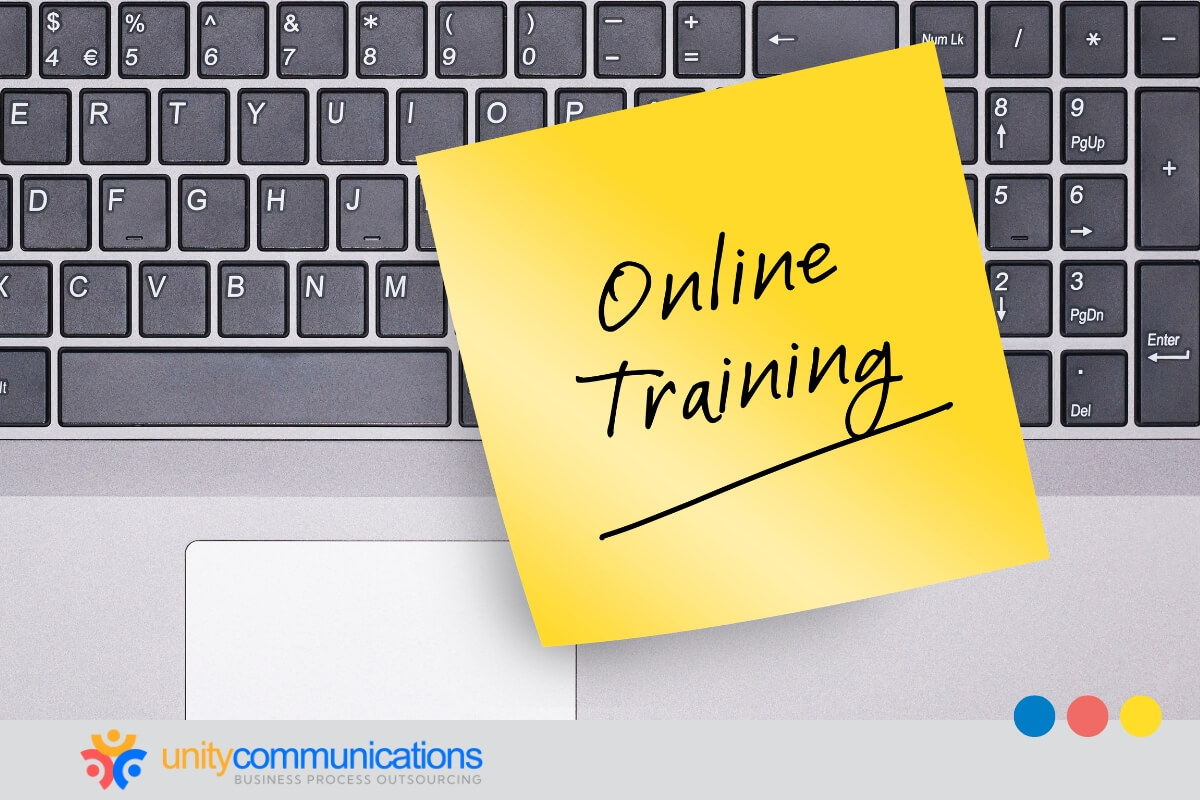Table of Contents
Outsourced training programs fall short when they rely on generic content. Business process outsourcing (BPO) introduces a better path through targeted, hands-on learning. Vendor-led training and upskilling support connect your teams with those who know the tools, workflows, and performance gaps best.
This approach speeds up onboarding, sharpens job readiness, and strengthens long-term development. Keep reading to explore eight practical ways vendors power more effective training and upskilling in real-world settings.
Why vendor-led training delivers superior results

What is BPO, and how does it support vendor-led training? Through BPO partnerships, companies access vendors offering hands-on, contextual learning. This real-world training is especially useful when speed, precision, and scalability are key.
Vendor-led training blends instructor–led and online training formats. This mix helps team members absorb new tools and workflows faster. Programs are structured around active needs, not theories, for quicker adoption and stronger performance from day one.
The global collaboration tools market, essential for vendor-led training, could grow from $39.4 billion in 2023 to $116.3 billion by 2033. This indicates increasing reliance on these applications to support scalable, remote-first training programs. Here’s how this approach delivers clear advantages:
- Immediate relevance to outsourced tools and tasks
- Faster onboarding and knowledge transfer
- Access to vendor experts for skill development
- Flexible delivery that supports shifting schedules
With vendor-led training and upskilling support, you gain more than skills. They tap into structured knowledge, hands-on delivery, and practical follow-through. They identify areas for improvement, tailor sessions according to team needs, and build lasting capability.
8 ways vendor-led training works
Vendor-led training and upskilling support can provide significant value. You can simplify training efforts by leveraging service providers’ expertise and different learning methods that enhance engagement and workforce skills.
Consider the eight approaches vendor management drives effective, comprehensive training and training course delivery:
1. Spot skill gaps through daily vendor interaction
Vendors interact with your teams daily. They see how work gets done, where delays happen, and which tasks slow people down. This visibility helps spot overlooked skill gaps.
By sharing frontline observations, third-party contractors can pinpoint training needs that match real conditions. You receive tailored upskilling help from BPO vendors, shaped around your operations. Here’s how vendors help uncover gaps:
- Flagging common questions that signal weak understanding
- Spotting mismatches between tool features and user behavior
- Reporting recurring support requests linked to training gaps
Collaboration helps match programs to specific workflows, not generic roles. This makes upskilling more focused and valuable.
2. Embed training directly into vendor contracts
Vendor management does more than track outcomes and costs. It also shapes how consistently your teams gain new skills. By structuring training into vendor agreements, learning becomes part of the service. To formalize this support, outline key elements in your agreements:
- Required modules tied to daily tools and workflows
- Frequency and format of sessions (live, self-paced, blended)
- Service level agreements (SLAs) for trainer access and tracking
- Responsibility for keeping content up to date
When vendor-led training and upskilling support are included in contracts, providers treat it as a core duty. Training is part of their delivery model, leading to better follow-through and consistency.
3. Co-develop learning content with vendors
Collaborating with vendors can align training with workflows, minimize wasted time, and develop e-learning content that targets tools, tasks, processes, and compliance requirements. Vendors bring their expertise to co-create training directly applicable to your environment.
This avoids generic content and confirms that every lesson supports your team’s needs. Here’s how co-development enhances training:
- Tailored content based on workflow
- Compliance-specific training modules
- Vendor input on industry updates
The global e-learning market could grow from $295.6 billion in 2025 to $844.3 billion by 2033. This increase signals growing demand for targeted, practical learning experiences.
4. Speed up onboarding through vendor expertise
New teams usually waste time figuring out where to start. Vendor-led onboarding can expedite the process. Vendors can walk new employees or providers through systems, tools, and workflows to reduce ramp-up time and confusion about roles or processes. Expect smoother handoffs when vendors guide the onboarding process:
- Live walkthroughs of tools and dashboards
- Q&A sessions to resolve confusion early
- Real-time examples tied to daily tasks
Vendor-led training and upskilling support provide teams instant access to insider knowledge. Instead of reading guides, your employees and partners hear directly from those who built the platform or manage service delivery. These early sessions minimize rework and clarify expectations immediately.
5. Use vendor platforms for continuous learning
Training is not a one-time occurrence. Vendor-hosted platforms allow you to hold sessions regularly, whether for monthly updates or an in-depth look at the latest developments. On-demand libraries enable teams to access content anytime, without regard for internal scheduling or teacher availability. These platforms support ongoing growth through:
- Centralized access to updated training material and certifications
- Recurring learning paths and user-specific tracks
- Built-in progress tracking and reporting
- Instant feedback loops to reinforce the correct application
- Interactive formats, quizzes, and role-based modules to improve retention
Rather than isolated learning, vendor technologies encourage recurring engagement and real-time skill development.
6. Align vendor training with business goals
Training becomes more effective when it supports your organization’s specific goals. Share workforce plans, key performance indicators (KPIs), and compliance benchmarks with your vendors. They can use the information to fine-tune learning content, aligning it with real performance targets. Other ways to coordinate vendor efforts include:
- Map training content to department metrics
- Review learning progress during performance check-ins
- Adjust sessions based on quarterly shifts or metrics gaps
- Include internal timelines, tool adoption roadmaps, and pain points in training plans
When vendors understand the training direction, their content better reflects your priorities. You get programs that address what matters most, speeding adoption, boosting scores, or hitting audit-readiness.
7. Measure training impact with real-time analytics
Without proper tracking, training loses its impact. Vendor-led training and upskilling support give you access to metrics that connect learning to business outcomes, such as:
- Completion rates by module or role
- Post-training assessments and score trends
- Engagement across different formats (live, self-paced)
- Links between training and operational KPIs
Track participation using attendance logs, engagement stats, and quiz results to maximize these insights. Use vendor dashboards or exports to review training progress in real time.
Analyze performance by department or region to uncover trends. For example, varying completion rates might highlight the need to adjust delivery methods or improve trainer availability.
8. Plan future training with vendor insights
Training doesn’t stop after onboarding. Vendors can refine multi-year roadmaps based on system updates, workflow shifts, or performance feedback. Their input helps guide future planning with clear, timely insights.
A recent LinkedIn report shows that roughly 36% of companies have impactful career development programs. About 31% show limited adoption, while 33% lack initiatives or are just starting. These data signal missed long-term planning. Service providers support future-focused development through:
- Recommending annual refresh timelines
- Suggesting training updates tied to role or region
- Flagging upcoming compliance changes
- Aligning sessions with shifting service goals
With vendor-provided training and upskilling assistance, your teams gain more than short-term skills.
The bottom line

Vendor-led training and upskilling support bring significant value by providing tailored, real-time learning that drives performance and enhances skill development. Organizations leveraging service provider expertise improve onboarding, foster continuous training, and align long-term upskilling with internal goals.
This approach contributes to better outcomes, reducing ramp-up time and strengthening workforce capabilities. Let’s connect and discuss how third-party training and upskilling support can empower your team and elevate your business results.




